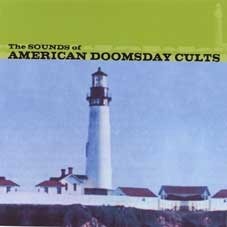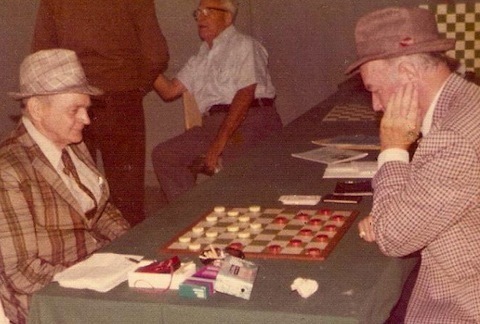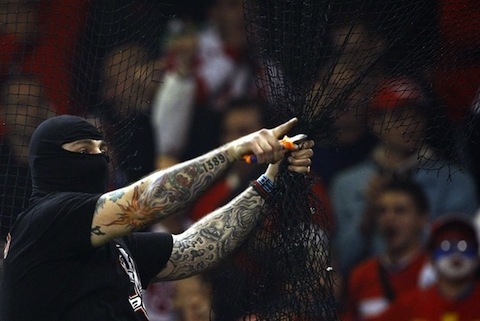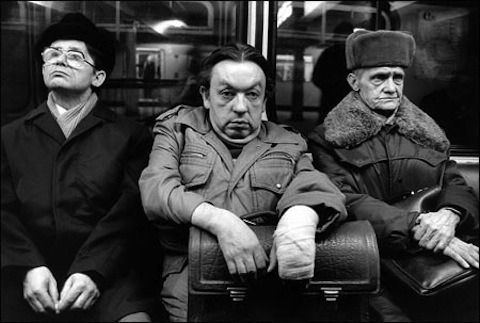Brendan I. Koerner's Blog, page 43
May 20, 2011
We've Been Here Before
 I'm scheduled to begin a long journey to the southwest Oregon coast tomorrow, and thus have spent a good deal of the morning getting ready for the trip. While making sure that my digital recorder had enough battery juice to serve me well, I had an unexpected twinge of worry: What if the nutters handing out leaflets at the Times Square subway station are right, and tomorrow really is Doomsday? Will U.S. Airways credit me for the ticket, or will I simply be out the $422?
I'm scheduled to begin a long journey to the southwest Oregon coast tomorrow, and thus have spent a good deal of the morning getting ready for the trip. While making sure that my digital recorder had enough battery juice to serve me well, I had an unexpected twinge of worry: What if the nutters handing out leaflets at the Times Square subway station are right, and tomorrow really is Doomsday? Will U.S. Airways credit me for the ticket, or will I simply be out the $422?
My moment of panic didn't last, however, as my mind quickly turned to past Doomsday predictions that have proven wholly incorrect. My favorite of recent vintage was April 23, 1990, which the Church Universal and Triumphant (CUT) said would mark the beginning of a global nuclear holocaust; CUT's members would weather the annihilation in a Montana fallout shelter, then presumably emerge to enjoy some sort of post-apocalyptic Paradise free of sin, gun-control laws, and processed foods.
CUT and its leader, the deliciously named Elizabeth Clare Prophet, have largely faded from our collective memory. But fortunately for the history books, they did leave behind an important artifact of their lunacy: The Sounds of American Doomsday Cults, an album that collects Prophet's sermons against all that allegedly ailed American society. Audio samples here, along with this brief description of how Prophet rolled when at the pulpit:
This record features live recordings of Clare Prophet 'speaking' out against the evils of rock music. She sounds perfectly normal as she introduces her 'psalms' or 'songs' or 'speeches' or whatever they are. But when she gets going, it's amazing. And so goddamn insane sounding. Her rapid fire high pitched testifying sounds a bit like an impossible mix of an auctioneer, a yodeller, the guy who sings the directions at a square dance, Neil Hamburger huffing helium and variations of baseball's 'hey batter batter' chant only faster. It's like that sound you make when you sort of hum/breathe out and move your finger up and down between your lips making a sort of 'bebubebubebubebubebubebubebubebu' sound. It's one of the most amazing things we've ever heard!
When 4/23/90 passed without incident, the CUT took up a new cause of slightly less importance: preserving its tax-exempt status by any means necessary. I assume the May 21st-ers will shift over to something similarly benign once they wake up in their own beds on Sunday morning.
May 19, 2011
Sportverbot
 Writing about the hammer throw has got me thinking a lot about Soviet Bloc athletics, and in turn one of the phenomena that fascinated me during my youth: East-to-West defectors. I was always drawn to tales of sportsmen from the other side of the Iron Curtain who decided to chuck it all and start anew in the NATO-land. A big part of the appeal was my sense that these defectors, in their own bizarre way, living the quintessential American dream, which is all about personal reinvention. (Jay Gatz, anyone?) To a grade schooler who didn't quite understand the importance of family ties and the psychological comforts of home, bolting from one's hotel during a competition and seeking asylum at the closest Western embassy seemed like the grandest of grand adventures.
Writing about the hammer throw has got me thinking a lot about Soviet Bloc athletics, and in turn one of the phenomena that fascinated me during my youth: East-to-West defectors. I was always drawn to tales of sportsmen from the other side of the Iron Curtain who decided to chuck it all and start anew in the NATO-land. A big part of the appeal was my sense that these defectors, in their own bizarre way, living the quintessential American dream, which is all about personal reinvention. (Jay Gatz, anyone?) To a grade schooler who didn't quite understand the importance of family ties and the psychological comforts of home, bolting from one's hotel during a competition and seeking asylum at the closest Western embassy seemed like the grandest of grand adventures.
One tale that stuck in my mind was that of the East German discus thrower Wolfgang Schmidt (right). After flubbing an escape attempt, Schmidt was tossed in jail for over a year, after which he was declared Sportverbot—forbidden from ever again practicing the athletic craft to which he had dedicated his young life. This fantastic Sports Ilustrated account of Schmidt's tribulations and eventual is a longread well worth your time. A typically awesome (and disturbing) snippet:
Wolfgang Schmidt—decorated superstar of the German Democratic Republic, holder of the world record in the discus throw, possessor of an Olympic silver medal, owner of two Orders of Merit of the Fatherland—groaned in pain as he stretched out on his bed of boards and fought to keep himself from going insane. "I played a mind game with myself, pretending that I was only an actor making a film about prison and that the shooting schedule was dragging out longer than it should, but that nothing could be done about it. I also relived all my memories, my visits abroad, my conversations with old friends in the West. Sometime around the seventh day of my second 10 days in solitary, Wiedemann came from Berlin. We did not meet in my stinking cell. He summoned me to an office downstairs. There, he berated me: 'Have you gone crazy? Do you want to add two years to your sentence? I suggest you withdraw the exit visa request.' "
Schmidt was alarmed, but he did not rescind the application. When he was released at the end of his second 10 days in solitary, he had lost 13 pounds, and his back was still sore from the beating as well as from sleeping on boards for so long. He returned to a cold reception from his cellmates. "They did not offer sympathy," he recalled. "Most of them had disliked me because I was famous and had seen the world. When I got into trouble, most of them were gloating that the authorities had punished a decorated athlete who had lived better than they."
Schmidt returned to the bleak routines of the KFZ, but he felt something strange in the air—a sense that people were watching him, waiting for something. Finally, Zidorn told him that the word was out that the authorities had decided to break Schmidt for good unless he withdrew his exit visa application. "They'll never let you leave the country, Wolfgang," said the swindler. "They'll put you in solitary again and again."
Frightened at the thought of another stretch of solitary, Schmidt notified Wiedemann that he had changed his mind about leaving the G.D.R. The Stasi insisted that Schmidt put his decision in writing. He wrote verbatim what Wiedemann dictated: "Herewith I withdraw my application for an exit visa. It is my wish to work in the G.D.R. as a coach in the throwing events or as the caretaker of a fitness club." Wiedemann insisted that Schmidt add, "My decision is voluntary."
More on the glamour of Cold War defection shortly, once I get a bit farther along in this draft.
May 18, 2011
"Maybe a Kiss in the Dark, Maybe a Knife in the Back"
Today's all about putting nose to grindstone and writing about the greatest hammer thrower who ever lived, so not much time to Microkhan, alas. But I leave you with a delectable treat: the trailer to 1973′s Wonder Women, which absolutely should have triumphed over The Great Gatsby for the Best Costume Design Oscar. Just check out the surgical uniforms sported by Nancy Kwan's medical minions—probably not great for preventing operating-room infections, but otherwise commendable in every regard.
May 17, 2011
Transporting Hammerheads

I surely can't be the only aquarium patron who, when confronted with a vast array of exotic sealife sealed behind glass, can only wonder how the largest of those captive animals was transported to their new homes. Sharks, of course, present special challenges, given their size and potential ferocity. And no shark species has proven more problematic for aquariums than the hammerhead, a delicate creature that has historically demonstrated itself to be quite averse to being cooped up for hours on end. Notes on the Long-term Transport of the Scalloped Hammerhead Shark (Sphyrna lewini ) (PDF) provides some history of the evolution of the requisite techniques, including the design of the containment unit pictured above. The latest results, though better than in years past, are unlikely to please those who object to keeping sharks in captivity:
The shortest-duration transport of 42 hr yielded an 83% survival rate 2 weeks after the arrival of the sharks in Beijing. The longest-duration transport to Rotterdam of 70 hr yielded a 33% survival rate, while the transport to Lisbon of 60 hr yielded an 83% survival rate. Throughout the shipments, the sharks appeared to be able to avoid both the walls of the containers and the conspecifics with ease, sustaining no external physical injuries through repeated collisions.
I've done you the kindness of snipping and posting the paper's best chart here. Perhaps the high mortality rate explains why those super-intelligent makos from Deep Blue Sea felt compelled to exact some measure of revenge.
May 16, 2011
Would These Men Juice?

For obvious reasons, I have been avidly following the performance of Mongolian grandmaster Dul Erdenebileg at the ongoing World Draughts Championship in The Netherlands. (Previous checkers-related posting here.) In the course of keeping up on the tourney's matches, I noticed something rather odd: the organizing body is apparently quite serious about drug testing. The complete rules and regulations, listed here in PDF format, are just as stringent as in more physical pastimes. A small snippet of what the checkers drug cops are looking for, translated from the Dutch:
The sample should be sent to an accredited laboratory from WADA for the analysis. Approximately, the laboratory will send the result of the test back within three to four week. The sample will be screened for stimulants, for narcotics, for B-blockers, for diuretics, for anabolic agents, including endogenous steroids, for cannabis, for B2-agonists, for hormone antagonists and modulators, for hCG (males only) and for glucocorticosteroids using the methods in their accreditation scope.
I find this a bit puzzling, as I question whether any of the drugs listed above can actually help sharpen performance in checkers. Perhaps B-blockers can have some small effect by combating nerves, but the other forbidden drugs seem unlikely to aid in mental acuity.
That's not to say there aren't some chemical enhancements that might give a checkers competitor an edge. The first drug that popped to mind was modafinil, which enhances alerteness amog those functioning on little sleep (perhaps because they stayed up late studying an opponent's endgame weaknesses). But what about a more out-there pharmaceutical tipple such as donepezil, which is frequently prescribed to Alzheimer's patients? It has been shown to improve performance in otherwise healthy pilots who, like checkers champs, must remember long lists of maneuvers under extreme pressure.
If there's a Victor Conte of checkers, I am going to make it my journalistic mission to find him.
(Image of the legendary 1975 Illinois Open match between Bobby Martin and Dick Fortman via the Online Museum of Checkers History)
May 13, 2011
I'm Gonna Beat This Deadline Now
Lost a day to partially feigned child illness this week, so scrambling to meet yet another Wired deadline before a preschool picnic. Apologies for not yet following through on installment two of the Ponchos; next Friday, for sure.
May 12, 2011
Pawns in the Game

Is there any professional sports league in the world more troubled than Serbia's top soccer division? Yesterday's championship ended in utter confusion, after one side walked off to protest some questionable refereeing. Though I haven't yet seen video of the plays in question, the losing players had every right to be suspicious—Serbia has endured its fair share of match-fixing scandals in recent months, not to mention death threats levied against officials and numerous riots. If ever a sports league was in need of a latter-day Kenesaw Mountain Landis to clean things up, Serbia's top division is it.
One of the things I find saddest about the league's woes is the fact that the hooligans at the heart of its problems are simply tools of powerful interests bent on undermining the popularly elected government. Among the puppet masters is fugitive drug lord Darko Saric, who allegedly egged along a riot in Italy last year:
Serbia face a ban from international football after their supporters rioted and caused Tuesday night's Euro 2012 qualifier with Italy in Genoa to be abandoned after six minutes. Italian police arrested 17 people, including the ring leader who was found hiding in the boot of a bus, following the violence that left 16 people, including two policemen, injured…
Reports from Serbia yesterday said the riot was an orchestrated demonstration of political violence designed to destabilise the pro-Western government and alienate the country from the rest of Europe. The drug baron Darko Saric, who is on the run, was allegedly behind the ugly scenes that included thugs fighting with riot police and throwing flares on to the pitch, one of which nearly hit the Italy goalkeeper Emiliano Viviano.
More on the high-level manipulation of Serbian soccer hooligans in this 2004 piece, which describes how Belgrade's most feared fan group is bent to serve ultra-nationalist causes. I have to wonder whether the majority of hooligans realize they're being conned by those who care more about political power than sport. I'm guessing no; this guy certainly doesn't look like much of a critical thinker.
(By the way, Darko Saric isn't just confining his anti-government campaign to the soccer pitch; he's also become fond of lobbing missiles at those who might dare speak against him.)
May 11, 2011
The Revolution Will Not be Besotted

Did East Germany contribute to its own demise by launching an official program to combat alcoholism? New research, packaged under the ominous title The Blue Strangler (a nickname for cheap vodka), makes the case:
Despite the steep prices, high proof alcohol was popular and the average GDR citizen drank 23 bottles of liquor a year – more than double the amount consumed by the average citizen of the Federal Republic of Germany. This high per capita consumption made the GDR the world's heaviest drinker when it came to spirits. Statistics from 1988 suggest that the average GDR citizen also knocked back 12 liters of wine and 146 liters of beer a year…
Party officials did not know how to deal with the problem. It wasn't until 1983, when the documentary film "Addicted" was produced by state-run film company, DEFA, that the dangers surrounding alcohol were spelled out. The film tells viewers about Rostock-based shipbuilding company Neptun Werft's in-house alcohol support center. As it began to feature more prominently in the media, alcohol abuse became a subject of public debate in the late 1980s.
As a result, there was a noticeable decline in consumption. A report written by the Council of Ministers in 1989 found that people had bought 82 hectoliters less alcohol than in the previous year. When the peaceful Monday demonstrations against the authoritarian government of the GDR got underway in autumn 1989, alcohol consumption sank to a historic low within a matter of weeks.
Correlation is not causation, of course, but there is something to the argument that a drunken populace is one not prone to anti-establishment tendencies. Alcohol is a drug that, when taken in excess by certain individuals, leads to decidedly anti-social behavior. But those in power are just fine with yobs braining each other with two-by-fours in the streets; what they fear is the more cerebral sort of unrest that can only be the result of clear-headed debate.
(Image of disgruntled East German commuters by Harald Hauswald)
May 10, 2011
Picking Up the Yurts
Out in the outer boroughs today, trying to hook up a geographical shift for Microkhan world headquarters. As much as I've loved living in Atlah, this shoebox-sized abode has become intolerable; I blame all lousy writing on the fact that I've been reduced to working on the floor of Microkhan Jr.'s room during school hours. As I sniff around for brand new digs, enjoy the footage of history's greatest hammer throwers; note how the wind-and-spin technique has become much more refined over the decades.
May 9, 2011
Soft Time in Finland
Buried in this account of a Rwandan-born, Kansas-based octogenarian who may be a genocidaire is an interesting tidbit regarding Finnish jurisprudence:
Mr. Kobagaya did not come to the United States government's attention until December 2007, when he agreed to testify as a defense witness on behalf of a former neighbor, Francois Bazaramba, in a trial in Finland. Mr. Bazaramba was facing charges that he had organized the genocide in Birambo. Finnish prosecutors tipped off American officials about Mr. Kobagaya's testimony, which showed he was in Rwanda during the genocide, not Burundi. (Last summer, Mr. Bazaramba was convicted on genocide charges and sentenced to life in a Finnish prison.)
There is something slightly dissonant about the phrase "Finnish prison," perhaps because Finland's penal system is so famously easygoing. This 2003 piece makes the case that life in a Finnish correctional facility ain't half bad:
Walls and fences have been removed in favor of unobtrusive camera surveillance and electronic alert networks. Instead of clanging iron gates, metal passageways and grim cells, there are linoleum-floored hallways lined with living spaces for inmates that resemble dormitory rooms more than lockups in a slammer.
Guards are unarmed and wear either civilian clothes or uniforms free of emblems like chevrons and epaulettes. "There are 10 guns in this prison, and they are all in my safe," Mr. Aaltonen said.
"The only time I take them out is for transfer of prisoners."
At the "open" prisons, inmates and guards address each other by first name. Prison superintendents go by nonmilitary titles like manager or governor, and prisoners are sometimes referred to as "clients" or, if they are youths, "pupils."
"We are parents, that's what we are," said Kirsti Njeminen, governor of the Kerava prison that specializes in rehabilitating young offenders like Mr. Syvajarvi.
Generous home leaves are available, particularly as the end of a sentence nears, and for midterm inmates, there are houses on the grounds, with privacy assured, where they can spend up to four days at a time with visiting spouses and children.
"We believe that the loss of freedom is the major punishment, so we try to make it as nice inside as possible," said Merja Toivonen, a supervisor at Hameenlinna.
I by no means think that America's penal system should be similarly cozy. But I am curious to know more about how Finland's style of incarceration, which began in the early-to-mid-1990s, has affected the nation's crime rate. One thing I do know right off the bat, and which may raise some issues: Finland has an unusually high homicide rate, especially in its northern provinces.




